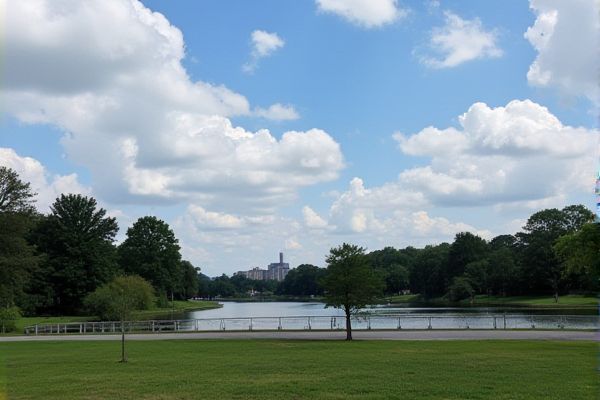
Weather and climate in Arkansas: Humid subtropical climate. Hot, humid summers. Mild winters. Occasional snowfall. Frequent thunderstorms. Tornado risk. Seasonal flooding. Variable spring weather. Fall foliage beauty. Hurricanes affect indirectly.
Humid subtropical climate.
Arkansas is classified as having a humid sub-tropical climate, characterized by hot, humid summers and mild, slightly drier winters. The region experiences four distinct seasons and significant weather extremes that are influenced by its topography and proximity to the Gulf of Mexico. For a more comprehensive understanding of Arkansas's diverse climate conditions, you can visit the Encyclopedia of Arkansas, which provides detailed insights into the state's climatic patterns.
Hot, humid summers.
Arkansas experiences extreme heat and humidity during summer, with average high temperatures in July reaching 92°F and humidity levels often above 75%. This combination can lead to heat-related illnesses like heat exhaustion and heat stroke. To stay safe outdoors, it is crucial to maintain careful hydration, seek shade, and wear protective clothing. For more tips and information on how to safely enjoy the summer season, you can visit the Arkansas Outside website, which provides valuable insights on dealing with the state's hot weather.
Mild winters.
In Arkansas, winters are typically mild and short, with temperatures occasionally dipping into the teens or below, but rarely staying in single digits. January is usually the month with the heaviest snowfall, though snow is not abundant, and frosts become common starting in December. For more information about Arkansas, especially if you're considering studying there, check out the International Admission page at Hendrix College.
Occasional snowfall.
In Arkansas, occasional snowfall is more common in the northern and western regions, with areas like Bentonville and Harrison receiving over 9 inches of snow annually, while southern and eastern parts of the state typically see less than 3 inches per year. Snow usually falls in January, February, March, and December, with significant snow events being rare but potentially disruptive. For detailed Annual Snowfall Information, visiting a reliable source like Current Results can provide further insights into regional weather patterns.
Frequent thunderstorms.
Arkansas experiences frequent thunderstorms, particularly during the summer months and the spring season, with these storms often accompanied by hail, tornadoes, and heavy rainfall. The state's volatile weather includes a secondary severe weather season that peaks in November, with thunderstorms capable of producing torrential rainfall, damaging winds, and tornadoes. For more detailed information on the unique weather patterns and seasonal activities to enjoy, visit the Arkansas Weather Guide.
Tornado risk.
Arkansas experiences an average of 26 to 39 tornadoes annually, with the highest risk during spring and a secondary severe weather season in late fall and winter. The state's geography, including its rural nature and varied topography, contributes to higher fatality rates despite advancements in warning systems and emergency measures. For more detailed information on the impact and history of tornadoes in Arkansas, visit the Encyclopedia of Arkansas, which offers comprehensive insights into this significant natural phenomenon.
Seasonal flooding.
Seasonal flooding in Arkansas is exacerbated by climate change, with increasing temperatures and precipitation amplifying the risk, particularly along the Mississippi River. Since 1958, the amount of precipitation during heavy rainstorms in the Southeast has increased by 27 percent, and this trend is likely to continue, leading to more frequent and intense flooding events. For further reading on the impacts of climate change in the region, visit Climate Nexus.
Variable spring weather.
In Arkansas, spring weather is variable, with March marking the gradual transition from winter, often including one last snowfall. April is the first true spring month with consistently warmer temperatures and the highest average rainfall. This period is accompanied by the occasional potential for tornadoes and the onset of spring showers and sunshine. For more detailed information on this seasonal transition, visit the Hendrix College International Admission page.
Fall foliage beauty.
The best time to see Arkansas fall foliage is late October to early November, with peak colors varying by region. In Northwest Arkansas, the vibrant hues reach their pinnacle in late October, while Central Arkansas showcases its stunning palette in early November. Meanwhile, Southern Arkansas captivates visitors in mid-November, as the fall colors are beautifully influenced by cooler temperatures and adequate rainfall. Navigate through this colorful journey and explore tips on how to make the most of your visit by checking out more details on the Arkansas Frontier website.
Hurricanes affect indirectly.
Hurricanes and tropical cyclones rarely make a direct landfall in Arkansas but can affect the state indirectly through their remnants, bringing heavy rains, flash flooding, tornadoes, and strong winds, particularly during the months of June to October. For more detailed information on how these weather patterns impact Arkansas, you can refer to the official report by the National Weather Service.
